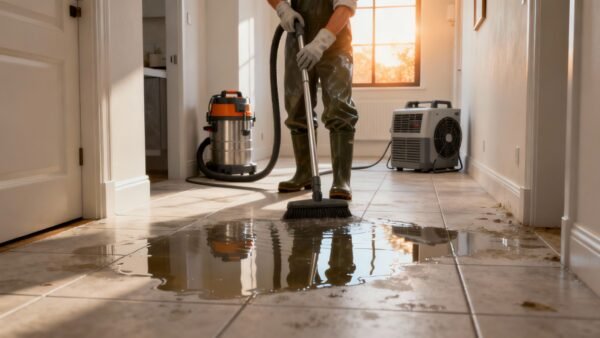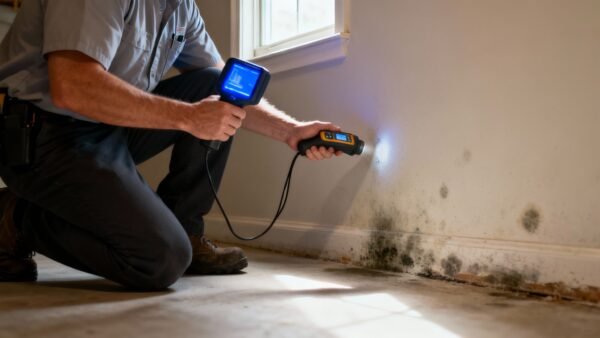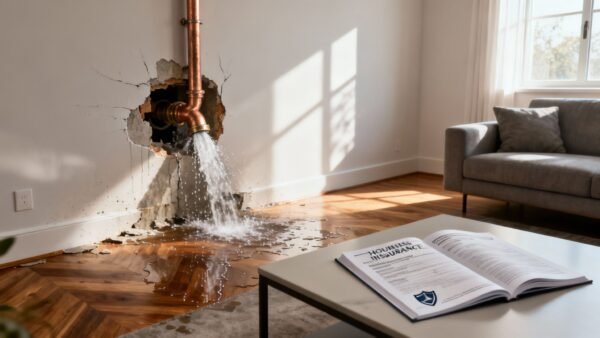When a pipe bursts in your Sherman Oaks home or a water heater gives out in West Hollywood, flooding your property, emergency water extraction services are the critical first responders. Think of these specialists as the cavalry for your home, showing up with industrial-grade equipment to pull out standing water before devastating damage takes hold. This first step is the most important one.
If you're facing a water emergency, don't wait. A fast response is the only way to prevent secondary damage like mold and structural rot.
Call (818) 336-1800 for a Free Assessment Now
What Exactly Are Emergency Water Extraction Services?
At its core, emergency water extraction is the professional service that physically removes massive amounts of water from a property—and does it fast. It's the critical first move in any water damage restoration project, designed to mitigate the immediate threat and prevent bigger headaches like mold and rot, which can start to colonize within just 24-48 hours.
This is worlds away from tackling a mess with a shop vac. We're talking about powerful, truck-mounted equipment built to handle major water intrusion. The service doesn't just address the puddles you can see; it targets the moisture that has already saturated your carpets, wicked up into the drywall, and seeped under the floorboards. The entire goal is to get your property as dry as possible, as quickly as humanly possible.
When Do You Need Professional Water Extraction?
Not every spill requires a five-alarm response, but some situations absolutely demand a professional's immediate attention. You’ll want to call for emergency services if you’re dealing with any of these scenarios:
- Burst Pipes or Major Leaks: When a supply line lets go, it releases a huge volume of water in a short amount of time, easily overwhelming any DIY cleanup attempt.
- Appliance Malfunctions: A broken washing machine hose in a Burbank laundry room or a failed water heater in a Pasadena garage can dump dozens of gallons into your living space before you even realize what's happening.
- Sewer Backups: This is a serious one. The water is contaminated ("black water") and poses significant health risks. It requires specialized gear, disinfectants, and handling procedures.
- Storm or Flood Damage: Water coming in from the outside, whether from a severe storm or flash flood, is almost always contaminated and tends to affect a much larger area, making professional extraction a must.
The name of the game is urgency. The less time water sits, the less damage it causes. Professional teams are geared up for large-scale removal and know how to find those hidden pockets of moisture you’d almost certainly miss on your own. To get a better sense of the full process, you can review a company's comprehensive cleaning and restoration services.
Why a Rapid Response is Critical After Water Damage
When water gets into your property, a countdown begins. Every single minute you wait, that moisture is seeping deeper into porous materials common in Los Angeles homes—drywall, wood flooring, insulation, and carpeting. What might start as a simple water issue can rapidly spiral into a massive, expensive structural nightmare.
This isn't a slow-motion problem. It only takes 24 to 48 hours for the perfect storm of conditions to brew, allowing mold to start growing behind your walls and under your floors. That small roof leak in your San Fernando Valley home can quietly lead to hidden rot, while a burst washing machine hose in West Hollywood creates an immediate crisis that needs professional emergency water extraction services to stop permanent damage in its tracks.
The Escalating Timeline of Damage
People consistently underestimate how fast water ruins a home. Even materials that feel dry on the surface can be holding onto a ton of moisture, creating a hidden breeding ground for contaminants that wreck your home's air quality and structural integrity. Waiting to act directly multiplies the financial and health risks you're facing.
This infographic breaks down just how quickly things go from bad to worse, starting from the first minute all the way to that critical 48-hour mark.
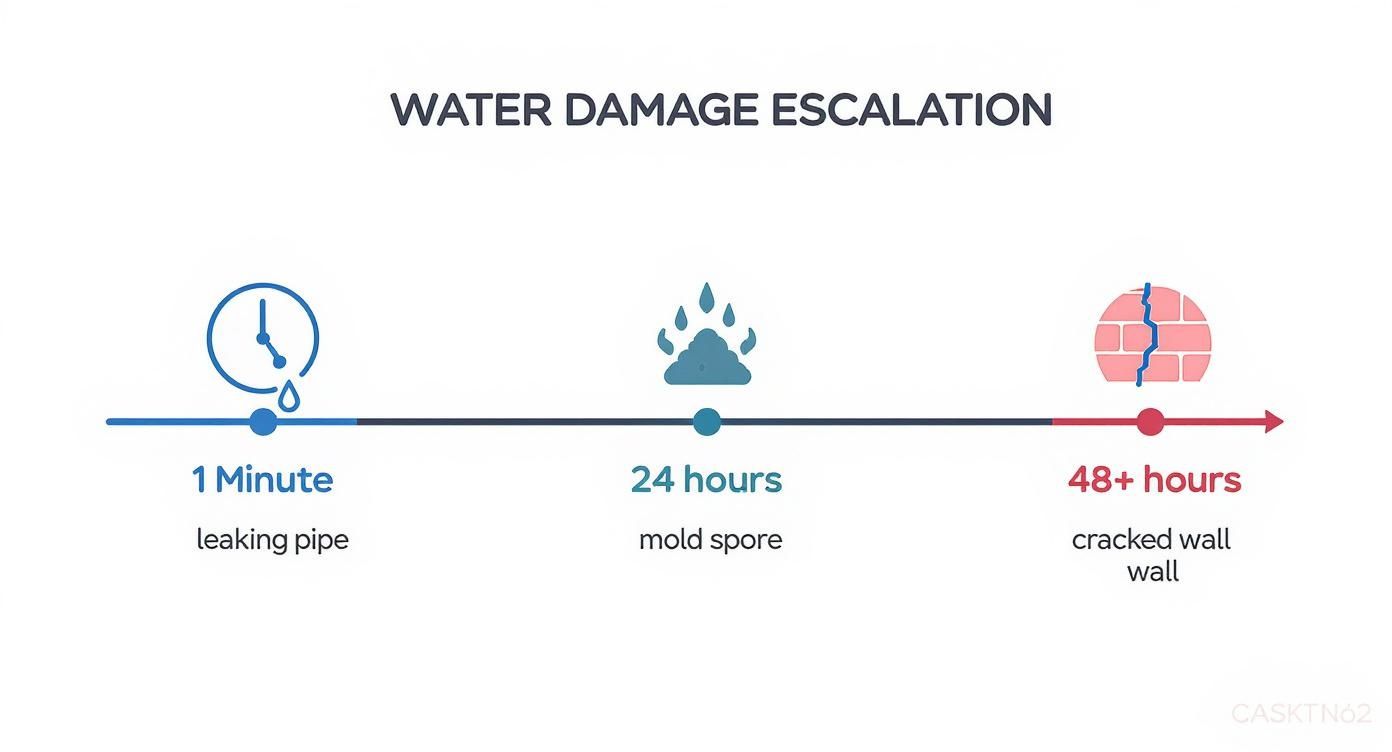
As you can see, a manageable problem becomes a serious structural and microbial hazard in just a couple of days. To put it into perspective, here's a closer look at what happens when you wait.
Water Damage Timeline: What Happens When You Wait
| Timeframe | Potential Damage and Risks |
|---|---|
| First Hour | Water spreads quickly across surfaces, absorbing into drywall, wood, and insulation. Finishes may stain. |
| 1-24 Hours | Drywall begins to swell and crumble. Wood flooring starts to buckle and warp. Metal surfaces can tarnish. |
| 24-48 Hours | Mold and mildew growth begins. Odors become noticeable. Structural components start to lose integrity. |
| 1 Week & Beyond | Major structural damage occurs. Mold contamination is widespread. Remediation costs increase dramatically. |
The takeaway is simple: the longer you wait, the worse it gets, and the more it costs to fix.
The Financial and Health Consequences of Waiting
Putting off the call for help is an invitation for secondary damage. We're talking about warped wood floors, crumbling drywall, and the arrival of mold, which is notorious for triggering allergies and respiratory problems. That's why it is so important to recognize the subtle signs of water damage as early as possible.
The sheer urgency of these services is clear when you look at the market. The global disaster restoration industry was valued at around USD 41.3 billion in 2023 and is expected to nearly double by 2033, largely because of an increase in damaging weather events. This growth just highlights how vital professional, rapid intervention truly is. You can discover more insights about the disaster restoration market on astuteanalytica.com.
The Professional Water Extraction Process Explained
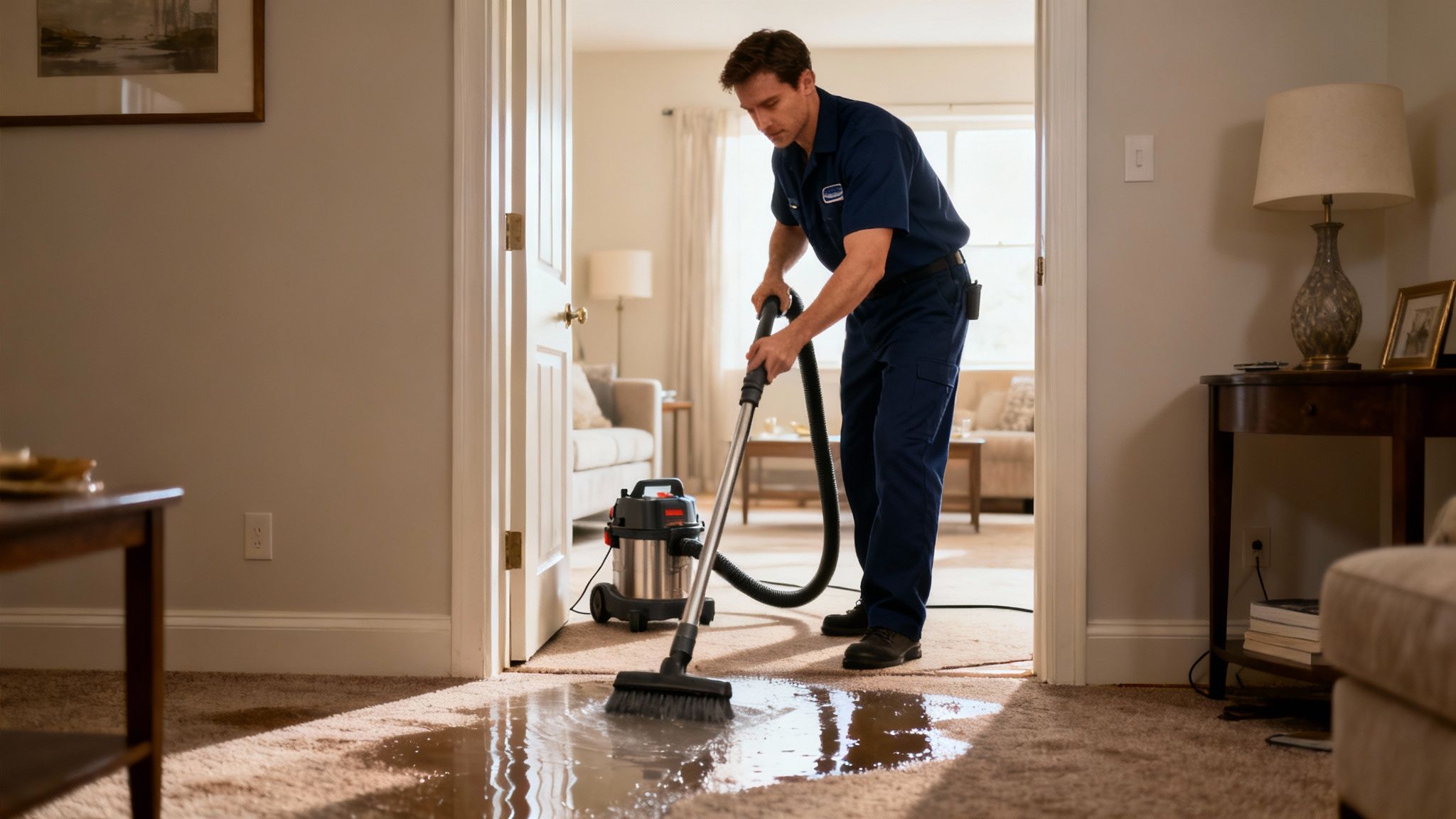
When you make that emergency call, a well-orchestrated process springs into action. Professional emergency water extraction services don’t just show up and start vacuuming; they follow a strict, science-based protocol to assess, contain, and fix the water damage safely and completely.
The first move is always an emergency assessment and safety inspection. Technicians arrive fast, find the source of the water, and shut it down. At the same time, they're performing a critical safety walkthrough, looking for live electrical hazards near standing water or structural dangers like a ceiling sagging under the weight of trapped water. This initial look dictates the entire game plan.
Locating and Stopping the Water Source
Before a single drop of water is removed, the leak has to be stopped. It’s that simple. A certified crew knows exactly how to find shut-off valves for burst pipes or isolate a malfunctioning appliance to stop the flow. This step is non-negotiable—it prevents a bad situation from getting exponentially worse while they work.
The Extraction Phase
This is where you see the massive difference between a DIY attempt and a professional job. A shop vac can pull up puddles, sure, but it’s powerless against the moisture that has soaked deep into porous materials like carpet padding, drywall, and wood.
Professionals roll in with powerful, truck-mounted extraction units. These machines create incredible suction, literally pulling water out of the carpet, through the pad, and even from the subfloor beneath.
The goal of extraction isn't just getting rid of visible water; it's about removing as much absorbed moisture as possible. This aggressive first step massively cuts down the time needed for the final drying phase, which is everything when it comes to stopping mold in its tracks.
Once the bulk water is gone, the real science starts. The next stage, called structural drying, is all about hunting down and eliminating that hidden moisture. To see how specialized equipment finishes what extraction starts, check out this guide on what homeowners need to know about structural drying. This two-part approach is what truly protects your home from long-term damage.
Specialized Equipment Used for Emergency Water Extraction
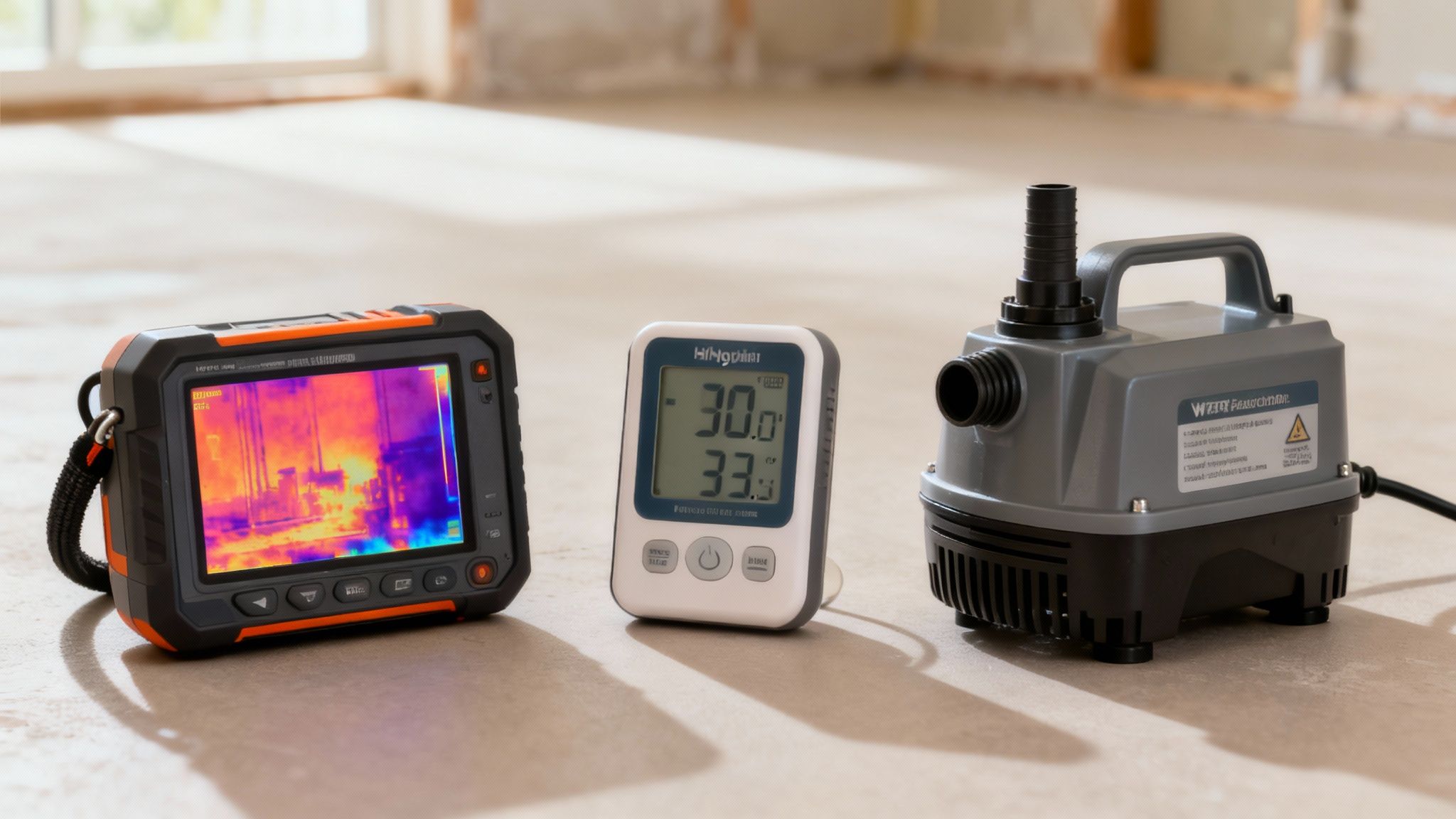
You can’t solve a serious water problem with shop vacs and household fans. The real difference between a quick cleanup and a professional restoration comes down to the specialized gear used to pull water out and find the hidden moisture that leads to mold and rot.
This isn't just about raw power, though that's part of it. While massive truck-mounted extractors provide the suction needed to pull standing water from deep inside carpet pads and subflooring, the most critical work is done with diagnostic tools that see what the naked eye can’t.
Tools That Uncover Hidden Moisture
The most important part of any water damage job is making sure every last drop of moisture is accounted for. If you leave moisture behind, you’re just asking for trouble down the road. That’s where this tech comes in.
- Thermal Imaging Cameras: Think of these as moisture-seeking x-ray vision. They detect tiny temperature differences in your walls and floors. Wet spots are always cooler, so they light up on the screen, showing us exactly where water is hiding behind drywall or under tile.
- Digital Hygrometers: These tools give us the hard data. They measure the exact amount of moisture in the air (humidity) and directly in materials like wood studs and drywall, telling us precisely how wet things are and when they're truly dry.
- Moisture Meters: We use both penetrating and non-penetrating meters to get precise moisture readings. They confirm when a surface is back to its normal, pre-loss condition, leaving no guesswork.
Advanced Drying and Air Purification Technology
Once the standing water is gone, the real science of drying begins. We set up high-velocity air movers to blast air across wet surfaces, which speeds up evaporation. Then, commercial-grade dehumidifiers work to pull all that newly released moisture out of the air.
If we're dealing with contaminated water (like a sewage backup) or there's a risk of mold, we bring in HEPA air scrubbers to clean the air itself. You can see how technicians use an air scrubber rental to capture dangerous particles and prevent them from spreading throughout your home.
The restoration industry is always evolving. A big focus right now is on self-contained, solar-hybrid systems that can keep the drying process going even if a storm knocks out the power grid.
How to Navigate Insurance Claims for Water Damage
Walking into a water-damaged room is overwhelming enough, but then comes the insurance claim—a process that can feel just as confusing. The good news is that with a clear head and a methodical approach, you can protect both your property and your claim.
The first rule is simple: document everything. Before a single thing is moved or cleaned up, pull out your phone and take detailed photos and videos of all affected areas. Capture the standing water, damaged furniture, soaked drywall—everything. This visual proof is your strongest asset when you file the claim.
Next, call your insurance agent to report the damage right away. Have your policy number handy and be ready to explain what happened as clearly as you can.
The Role of a Professional Restoration Company
This is the point where a professional emergency water extraction services company becomes your most critical partner. Your insurance company isn't just going to take your word for it; they need credible, detailed proof to process your claim. A certified restoration team provides exactly that.
They’ll create the official records your adjuster needs, including:
- Detailed Damage Reports: A complete assessment of every area and material affected by the water.
- Moisture Readings: Scientific data from specialized meters that prove how saturated your walls, floors, and structural elements really are.
- Professional Estimates: A clear, itemized quote for all the work required for extraction, drying, and restoration.
This professional documentation takes all the guesswork out of the equation. It gives the adjuster the hard evidence they need to approve your claim and helps make sure you receive the full coverage you're entitled to.
Understanding Your Policy
It's crucial to know what your policy actually covers. Most standard homeowners insurance policies are designed for damage that is "sudden and accidental," like a burst pipe. What they typically don't cover is damage from gradual leaks, poor maintenance, or flooding caused by natural disasters.
Knowing the fine print is key, especially when it comes to common issues like whether your homeowners insurance covers burst pipes. It’s also a good idea to dig into the details of homeowners insurance coverage for water damage to get a better handle on what you should expect from the process.
How to Choose the Right Emergency Water Extraction Company
When your home is flooding, the company you call can mean the difference between a fast recovery and a drawn-out nightmare. It's tough to think straight in a crisis, but picking the right partner for emergency water extraction services is one of the most important decisions you'll make.
Focus on a few key things to make a quick, smart choice.
First, check their certifications. The single most important credential to look for is from the IICRC (Institute of Inspection, Cleaning and Restoration Certification). This is the gold standard, proving their technicians are trained on the latest, safest, and most effective industry practices. Hiring a team without it is a serious gamble.
Next, make sure they’re truly available and local. A real emergency service means 24/7/365—no excuses. They should be able to guarantee a rapid response, ideally getting to you in under 90 minutes anywhere in the Los Angeles area. A local company knows the unique challenges here, from our coastal humidity to specific building codes.
Key Credentials to Verify
Before you agree to anything, run through this quick mental checklist. Any reputable company will have this information ready and waiting for you.
- IICRC Certification: This is non-negotiable. It’s your proof of professional, standardized training.
- License and Insurance: This protects you from any liability if an accident happens on your property during the cleanup.
- 24/7 Availability: Floods don't happen on a 9-to-5 schedule. You need a team that can be there when you need them most, period.
- Detailed, Written Estimates: A professional team will inspect the damage in person before giving you a transparent, itemized quote. Be wary of anyone who throws out a vague price over the phone.
If a company refuses to provide a written estimate or uses high-pressure sales tactics, that's a massive red flag. Your goal is to find a trustworthy partner, not just the cheapest quote that might cut dangerous corners.
The demand for qualified professionals is growing. The disaster restoration industry expanded from USD 32.6 billion to USD 41.2 billion between 2019 and 2023. This growth highlights just how critical it is to find properly trained experts. Read the full research about disaster restoration market trends.
For homeowners in Los Angeles, finding a reliable water damage restoration service near me is the final, most important step in taking back control of your property after a disaster.
Frequently Asked Questions About Water Extraction
When you're dealing with a water emergency, you’re bound to have questions. Here are some straightforward answers to the things Los Angeles homeowners ask us most about emergency water extraction.
How Much Does Emergency Water Extraction Cost?
The final price tag can swing quite a bit depending on a few key things: the size of the flooded area, the type of water involved (clean, gray, or black), and just how soaked materials like your drywall and subfloors are.
A small leak with clean water might only run a few hundred dollars. But extensive damage from something like a sewer backup? That can easily climb into the thousands. The only real way to know is to have a certified pro come out, assess the damage, and give you a detailed, on-site estimate.
Can I Just Use a Shop Vac to Remove Water?
A shop vac is great for a small spill on the surface, but it's completely out of its league in a real water damage situation. It just doesn't have the raw suction power to pull water that’s trapped deep inside carpet padding, wall insulation, or wooden subfloors.
Professional extractors are beasts by comparison. We always pair them with sensitive moisture meters to hunt down every last bit of hidden dampness. Skipping that step is how you end up with mold and rot down the line.
Think of it this way: a shop vac is like using a paper towel to clean up a spilled drink. A professional extractor is like the fire department showing up to a broken hydrant. The scale and power aren't even in the same ballpark.
How Long Does the Entire Process Take?
Getting the standing water out—the extraction part you can see—is usually done within a day. But the most important part is what comes next: the structural drying.
This is where we bring in high-velocity air movers and commercial-grade dehumidifiers to pull every last bit of moisture out of the structure itself. This phase typically takes another 3 to 5 days to do correctly. The total timeline really depends on how bad the damage is and what materials got wet.
Will My Homeowners Insurance Cover This?
Most of the time, yes—but there's a crucial catch. Standard homeowners insurance policies cover damage from "sudden and accidental" events. Think burst pipes, a washing machine hose that gives out, or a water heater that fails unexpectedly.
What they almost never cover is damage from slow, long-term leaks (that’s considered a maintenance issue) or natural floods. For water from a storm or rising river, you'd need a separate flood insurance policy. Your first move should always be to call your insurance agent right away to understand your specific coverage.
Don't wait. When it comes to water damage, a fast response is everything. It's the key to stopping mold before it starts and saving your property from more destruction. The IICRC-certified team at Onsite Pro Restoration is on call 24/7, ready to provide immediate, expert help.


